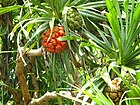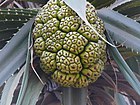Note: This is a project under development. The articles on this wiki are just being initiated and broadly incomplete. You can Help creating new pages.
Pandanus fascicularis - Fragrant Screw Pine
Pandanus facicularis is an aromatic monocot species of plant in the family Pandanaceae, native to Polynesia, Australia, South Asia (Andaman Islands), and the Philippines, and is also found wild in southern India and Burma. It is commonly known as fragrant screw-pine.
Contents
- 1 Uses
- 2 Parts Used
- 3 Chemical Composition
- 4 Common names
- 5 Properties
- 6 Habit
- 7 Identification
- 8 List of Ayurvedic medicine in which the herb is used
- 9 Where to get the saplings
- 10 Mode of Propagation
- 11 How to plant/cultivate
- 12 Commonly seen growing in areas
- 13 Photo Gallery
- 14 References
- 15 External Links
Uses
headache, rheumatism, spasm cold, flu, epilepsy wounds, boils, scabies leucoderma, ulcers, colic hepatitis, smallpox, leprosy syphilis, cancer, dysuric.
Parts Used
Chemical Composition
The major components of the Kewda oil were kewda ether, terpinen-4-ol, α-terpineol and 2-phenyl ethyl alcohol. [1]
Common names
| Language | Common name |
|---|---|
| Kannada | ಕೇದಗೆ kedage, ಕೇದಗಿ kedagi, ಕೇದಿಗೆ kedige, ಕೇತಕೆ ketake, ತಾಳೇ ಹೂ taale hu |
| Hindi | गगण धूल gagan-dhul, जम्बाला jambala, जम्बूल jambul, केओड़ा keora, केतकी ketaki, केंवड़ा kevara, पांशुका panshuka, पांसुका pansuka, पुष्प चामर pushp-chamar, तीक्ष्ण गन्धा tikshna-gandha |
| Malayalam | കൈനാറി kainaari, കൈത kaitha |
| Tamil | கேதகை ketakai, தாழை talai |
| Telugu | మొగలి mogali, గేదగ gedaga, గొజ్జంగి gojjangi, కేతకి ketaki |
| Marathi | NA |
| Gujarathi | NA |
| Punjabi | NA |
| Kashmiri | NA |
| Sanskrit | हनीलः hanilha, जम्बूल jambul, केतकी ketaki, पांशुका panshuka, पांसुका pansuka, सुगंधिनी sugandhini |
| English | Kewda, Fragrant Screw Pine, Umbrella tree, Screw pine, Screw tree |
Properties
Reference: Dravya - Substance, Rasa - Taste, Guna - Qualities, Veerya - Potency, Vipaka - Post-digesion effect, Karma - Pharmacological activity, Prabhava - Therepeutics.
Dravya
Rasa
Guna
Veerya
Vipaka
Karma
Prabhava
Habit
Identification
Leaf
| Kind | Shape | Feature |
|---|---|---|
| Simple | sword-shaped | Leaves grow in clusters at the branch tips, with rosettes of sword-shaped, stiff (leather-like) and spiny bluish-green, fragrant leaves. Leaves are glaucous, 40–70 cm. long |
Other features
List of Ayurvedic medicine in which the herb is used
Where to get the saplings
Mode of Propagation
How to plant/cultivate
The tree is propagated vegetatively, by the offshoots of young plants that grow around the base of the trunk, but may also be increased by seed. If by the former method, the offsets should be cut off and set in sand, at a temperature of 65° or 70°. The cuttings root slowly and the plants for a time make very slow growth. The general cultural treatment is that of palms. Trees require an abundance of water in summer. [3]
Commonly seen growing in areas
Photo Gallery
References
External Links
- Ayurvedic Herbs known to be helpful to treat headache
- Ayurvedic Herbs known to be helpful to treat rheumatism
- Ayurvedic Herbs known to be helpful to treat spasm
- Ayurvedic Herbs known to be helpful to treat cold
- Ayurvedic Herbs known to be helpful to treat flu
- Ayurvedic Herbs known to be helpful to treat epilepsy
- Ayurvedic Herbs known to be helpful to treat wounds
- Ayurvedic Herbs known to be helpful to treat boils
- Ayurvedic Herbs known to be helpful to treat scabies
- Ayurvedic Herbs known to be helpful to treat leucoderma
- Ayurvedic Herbs known to be helpful to treat ulcers
- Ayurvedic Herbs known to be helpful to treat colic
- Ayurvedic Herbs known to be helpful to treat hepatitis
- Ayurvedic Herbs known to be helpful to treat smallpox
- Ayurvedic Herbs known to be helpful to treat leprosy
- Ayurvedic Herbs known to be helpful to treat syphilis
- Ayurvedic Herbs known to be helpful to treat cancer
- Ayurvedic Herbs known to be helpful to treat dysuric
- Herbs with Flowers used in medicine
- Herbs with Leaves used in medicine
- Herbs with common name in Kannada
- Herbs with common name in Hindi
- Herbs with common name in Malayalam
- Herbs with common name in Tamil
- Herbs with common name in Telugu
- Herbs with common name in Sanskrit
- Herbs with common name in English
- Habit - Tree
- Index of Plants which can be propagated by Seeds
- Herbs that are commonly seen in the region of Lowland area
- Herbs
- Pandanaceae



